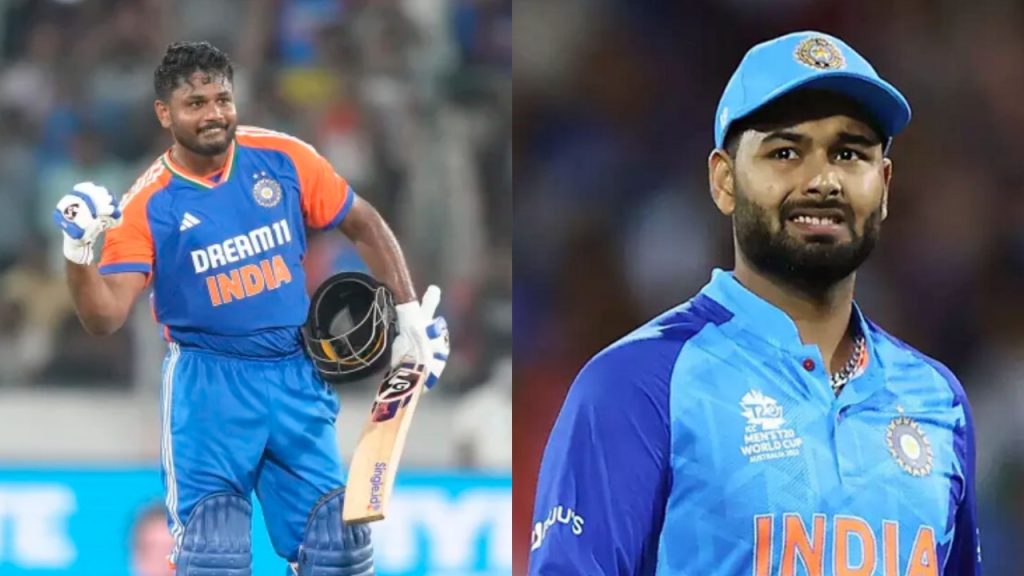As the Indian cricket team gears up for the ICC Champions Trophy 2025, the selection for the second-choice wicketkeeper has become a focal point of discussion. With KL Rahul as the primary choice, the competition between Sanju Samson and Rishabh Pant to be the ideal backup has intensified. Let’s delve into their ODI performances to see who has the edge.
Sanju Samson
Sanju Samson has played 16 ODIs, where he has had 14 innings with 5 not-outs. In these matches, he has amassed 510 runs, his highest score being an impressive 108. His average stands at a commendable 56.66, which is significantly high for someone with his number of matches. Samson’s strike rate of 99.60 reflects his ability to score quickly, making him a dynamic player in the middle order. He has one century and three half-centuries to his name, with 34 fours and 22 sixes. Behind the stumps, he has contributed with 9 catches and 2 stumpings. Samson’s numbers in ODIs suggest a player who, despite fewer opportunities, has made significant impacts when given the chance.
Rishabh Pant
On the other hand, Rishabh Pant has had more exposure to international one-day cricket with 31 matches under his belt. He has played 27 innings, with only one not-out, scoring 871 runs. His highest score is an unbeaten 125, showcasing his capability to anchor innings. Pant’s average of 33.50 is notably lower than Samson’s, but this figure comes with the caveat of having played more games, thus facing more diverse bowling attacks. His strike rate of 106.21 indicates a slightly better scoring rate than Samson, fitting well into the modern game’s demands for quick runs. Pant has one century and five fifties, with 91 fours and 26 sixes, showing his flair for aggressive play. His wicketkeeping stats are impressive too, with 27 catches and 1 stumping.
Statistical Comparison
When comparing their stats head-to-head, Samson boasts a higher average, which could be attributed to his fewer innings where he has had less opportunity to falter. However, Pant’s lower average comes with the experience of facing more international bowlers in varied conditions, which might suggest a robustness to his game under pressure. Samson’s strike rate is slightly lower, but not by a margin that would deem one superior in terms of run-scoring speed.
In terms of centuries, both have one each, but Pant has more half-centuries, indicating consistency in scoring significant runs. The difference in their six-hitting capabilities is marginal, with Pant leading slightly, which might be reflective of his more aggressive approach to batting.
Role in Team Strategy
Both players offer different dimensions to the Indian team. Samson appears as a calculated risk-taker, capable of stabilizing an innings or accelerating as needed, often playing match-winning knocks. Pant, known for his flamboyance, has shown he can change the game’s complexion with his aggressive batting, often turning the tide when required.
From a wicketkeeping standpoint, Pant has proven more reliable, especially in terms of catches, which is crucial in ODIs where every dismissal counts. Samson, though competent, has had fewer opportunities to showcase his skills behind the stumps in international cricket.
Looking Ahead to the ICC Champions Trophy 2025
As India prepares for their first match on February 20, 2025, the decision on who will be the second-choice wicketkeeper could hinge not just on numbers but on the strategic direction the team wishes to take. With KL Rahul likely to be the primary keeper-batsman, the backup role needs someone who can fill multiple roles – from stabilizing the innings to providing a late flourish with the bat, and being dependable behind the stumps.
Samson’s higher average might appeal for his consistency, but Pant’s experience and slightly better strike rate could make him the preferred choice if the team opts for a more dynamic approach in crucial matches. Moreover, Pant’s recent performances in other formats might weigh in his favor, offering him an edge in terms of current form.
In Summary
Both Samson and Pant have compelling cases, the statistical edge seems to tilt towards Samson when purely looking at averages and impact per innings. However, Pant’s broader exposure, higher match count, and his ability to perform under pressure might make him the more tactical choice for a high-stakes tournament like the Champions Trophy. The selectors will have a tough decision, but one thing is clear – both players are capable of stepping up when needed, potentially defining the role of the modern wicketkeeper-batsman in Indian cricket.

